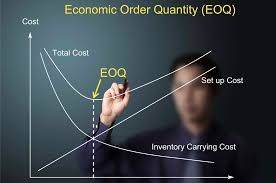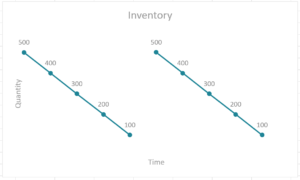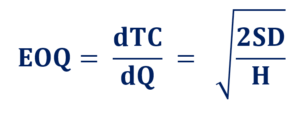EOQ stands for Economic Order Quantity. It is a measurement used in the field of Operations, Logistics, and Supply Management. In essence, EOQ is a tool used to determine the volume and frequency of orders required to satisfy a given level of demand while minimizing the cost per order.

What Is Economic Order Quantity?
Economic order quantity (EOQ) is the ideal quantity of units a company should purchase to meet demand while minimizing inventory costs such as holding costs, shortage costs, and order costs. This production-scheduling model was developed in 1913 by Ford W. Harris and has been refined over time.1 The economic order quantity formula assumes that demand, ordering, and holding costs all remain constant.
Formula for Calculating Economic Order Quantity (EOQ)
The Economic Order Quantity formula is calculated by minimizing the total cost per order by setting the first-order derivative to zero. The components of the formula that make up the total cost per order are the cost of holding inventory and the cost of ordering that inventory. The key notations in understanding the EOQ formula are as follows:
Components of the EOQ Formula:
D: Annual Quantity Demanded
Q: Volume per Order
S: Ordering Cost (Fixed Cost)
C: Unit Cost (Variable Cost)
H: Holding Cost (Variable Cost)
i: Carrying Cost (Interest Rate)
Ordering Cost
The number of orders that occur annually can be found by dividing the annual demand by the volume per order. The formula can be expressed as:

For each order with a fixed cost that is independent of the number of units, S, the annual ordering cost is found by multiplying the number of orders by this fixed cost. It is expressed as:
Holding Cost
Holding inventory often comes with its own costs. This cost can be in the form of direct costs incurred by financing the storage of said inventory or the opportunity cost of holding inventory instead of investing the money elsewhere. As such, the holding cost per unit is often expressed as the cost per unit multiplied by the interest rate, expressed as follows:
H = iC
With the assumption that demand is constant, the quantity of stock can be seen to be depleting at a constant rate over time. When inventory reaches zero, an order is placed and replenishes inventory as shown:

As such, the holding cost of the inventory is calculated by finding the sum product of the inventory at any instant and the holding cost per unit. It is expressed as follows:

Total Cost and the Economic Order Quantity
Summing the two costs together gives the annual total cost of orders. To find the optimal quantity that minimizes this cost, the annual total cost is differentiated with respect to Q. It is shown as follows:


The Importance of EOQ
The Economic Order Quantity is a set point designed to help companies minimize the cost of ordering and holding inventory. The cost of ordering inventory falls with the increase in ordering volume due to purchasing on economies of scale. However, as the size of inventory grows, the cost of holding the inventory rises. EOQ is the exact point that minimizes both of these inversely related costs.
What the Economic Order Quantity Can Tell You
The goal of the EOQ formula is to identify the optimal number of product units to order. If achieved, a company can minimize its costs for buying, delivering, and storing units. The EOQ formula can be modified to determine different production levels or order intervals, and corporations with large supply chains and high variable costs use an algorithm in their computer software to determine EOQ.
EOQ is an important cash flow tool. The formula can help a company control the amount of cash tied up in the inventory balance. For many companies, inventory is its largest asset other than its human resources, and these businesses must carry sufficient inventory to meet the needs of customers. If EOQ can help minimize the level of inventory, the cash savings can be used for some other business purpose or investment.The EOQ formula determines the inventory reorder point of a company. When inventory falls to a certain level, the EOQ formula, if applied to business processes, triggers the need to place an order for more units. By determining a reorder point, the business avoids running out of inventory and can continue to fill customer orders. If the company runs out of inventory, there is a shortage cost, which is the revenue lost because the company has insufficient inventory to fill an order. An inventory shortage may also mean the company loses the customer or the client will order less in the future.
Limitations of EOQ
The EOQ formula assumes that consumer demand is constant. The calculation also assumes that both ordering and holding costs remain constant. This fact makes it difficult or impossible for the formula to account for business events such as changing consumer demand, seasonal changes in inventory costs, lost sales revenue due to inventory shortages, or purchase discounts a company might realize for buying inventory in larger quantities.
FAQs
How Is Economic Order Quantity Calculated?
Economic order quantity is an inventory management technique that helps make efficient inventory management decisions. It refers to the optimal amount of inventory a company should purchase in order to meet its demand while minimizing its holding and storage costs. One of the important limitations of the economic order quantity is that it assumes the demand for the company’s products is constant over time.
How Does Economic Order Quantity Work?
Economic order quantity will be higher if the company’s setup costs or product demand increases. On the other hand, it will be lower if the company’s holding costs increase.
Why Is Economic Order Quantity Important?
Economic order quantity is important because it helps companies manage their inventory efficiently. Without inventory management techniques such as these, companies will tend to hold too much inventory during periods of low demand while also holding too little inventory during periods of high demand. Either problem creates missed opportunities.
Practice area's of B K Goyal & Co LLP
Income Tax Return Filing | Income Tax Appeal | Income Tax Notice | GST Registration | GST Return Filing | FSSAI Registration | Company Registration | Company Audit | Company Annual Compliance | Income Tax Audit | Nidhi Company Registration| LLP Registration | Accounting in India | NGO Registration | NGO Audit | ESG | BRSR | Private Security Agency | Udyam Registration | Trademark Registration | Copyright Registration | Patent Registration | Import Export Code | Forensic Accounting and Fraud Detection | Section 8 Company | Foreign Company | 80G and 12A Certificate | FCRA Registration |DGGI Cases | Scrutiny Cases | Income Escapement Cases | Search & Seizure | CIT Appeal | ITAT Appeal | Auditors | Internal Audit | Financial Audit | Process Audit | IEC Code | CA Certification | Income Tax Penalty Notice u/s 271(1)(c) | Income Tax Notice u/s 142(1) | Income Tax Notice u/s 144 |Income Tax Notice u/s 148 | Income Tax Demand Notice | Psara License | FCRA Online
Company Registration Services in major cities of India
Company Registration in Jaipur | Company Registration in Delhi | Company Registration in Pune | Company Registration in Hyderabad | Company Registration in Bangalore | Company Registration in Chennai | Company Registration in Kolkata | Company Registration in Mumbai | Company Registration in India | Company Registration in Gurgaon | Company Registration in Noida | Company Registration in lucknow
Complete CA Services
RERA Services
Most read resources
tnreginet |rajssp | jharsewa | picme | pmkisan | webland | bonafide certificate | rent agreement format | tax audit applicability | 7/12 online maharasthra | kerala psc registration | antyodaya saral portal | appointment letter format | 115bac | section 41 of income tax act | GST Search Taxpayer | 194h | section 185 of companies act 2013 | caro 2020 | Challan 280 | itr intimation password | internal audit applicability | preliminiary expenses | mAadhar | e shram card | 194r | ec tamilnadu | 194a of income tax act | 80ddb | aaple sarkar portal | epf activation | scrap business | brsr | section 135 of companies act 2013 | depreciation on computer | section 186 of companies act 2013 | 80ttb | section 115bab | section 115ba | section 148 of income tax act | 80dd | 44ae of Income tax act | west bengal land registration | 194o of income tax act | 270a of income tax act | 80ccc | traces portal | 92e of income tax act | 142(1) of Income Tax Act | 80c of Income Tax Act | Directorate general of GST Intelligence | form 16 | section 164 of companies act | section 194a | section 138 of companies act 2013 | section 133 of companies act 2013 | rtps | patta chitta

